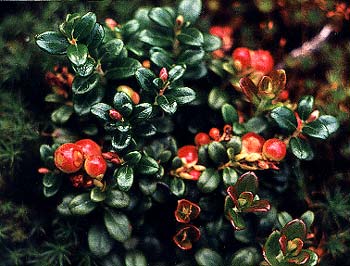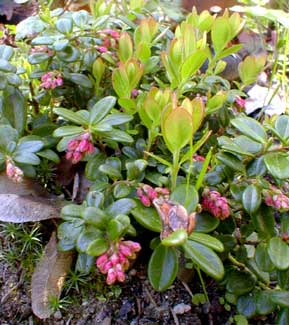
Dwarf Lingonberry
North American Mountain Cranberry
or Mossberry
"Her lips of crimson berries
Tempt mine to gather them."
-Yehuda ha-Levi
(1075-1141)
(1075-1141)
The first photograph of Vaccinium vitis-idaea var minus, or Dwarf Lingonberry, was snapped in July (2002). It is showing off it's long-lasting orange-red berries amidst glossy, fully evergreen leaves.
The second portrait is from April (2004) & shows it with spring's pink flowers, & a few new leaves still light-green, soon to harden to shiny dark green.
In the lower left hand corner of the second photo are a couple "sprigs" of tiny moss, which provide a scale by which it can be judged how really small this shrublet is.
 It is two to three inches tall, so the pictures are bigger than life-size. It is capable after several years of reaching a four or five inch height, of very tightly compact growth.
It is two to three inches tall, so the pictures are bigger than life-size. It is capable after several years of reaching a four or five inch height, of very tightly compact growth.The fruits are just as big as on any foot-tall full-sized lingonberry. Left on this tiny evergreen, the friuts last through most of the winter for a spot of color at a time when so much else is quiescent, leafless, flowerless, or died back.
This tiny form of lingonberry is sometimes called "Mossberry" because it is as small as many a moss or "Groundberry" for hugging the ground. It is a wild form that grows along the northeastern seaboard from Massachusetts & the rest of New England & the states of the Great Lakes region, northward to Labrador, across the upper Canadian Arctic (sub-Arctic) from Greenland to Alaska, & in the Northwest from islands of the Bering Sea to coastal British Columbia. It is the North American variant of a circumpolar species, the European & Asian equivalent ( V. vitis-idaea var majus) being a foot or a foot & a half tall.
Its pink & white bellflowers occur in April in our zone, & fruit is ripe by July. it blooms a second time in July/August with another crop ripe by early October. In its most northern range it only blooms & fruits once a year, & some populations surviving in the harshest conditions never manage to fruit at all but spread only by rhizomes. In Alaska for instance the spring flowering produces few or no berries either because there are too few pollinators abroad that early in the year, or the blooms are damaged by late frosts. So the primary fruit season is autumn, after summer pollination.
Lingonberry becomes rarer in its southern-most range which is odd because as a garden evergreen brought into temperate gardens, lingonberries thrive & fruit even better than they do in the wild, unlike so many other interesting alpine vacciniums that adapt poorly to domesticated conditions.
In the wild, dwarf lingonberry is an important food for black bears, foxes, & the redback vole. It is eaten by moose, squirrels, chipmunks, whitefoot mouse, hares, skunks, Canada goose, grouses & other birds, & even polar bears. Because the berries remain on the branches through the winter they are especially significant in autumn & winter for animals that can dig to them through snowcover, or as the very first fruit of spring upon snowmelt.
Lingonberries are poorly if at all wind-pollinated & require insect visitors. Throughout the dwarf form's North American range it is pollinated by many species of Bombus bumblebees, Adrenid bees (Adrena spp), & Halictid bees (Dialectus). In the garden honeybees (Apis mellifera) do the job just as well well. Aboriginal peoples from the Inuit to the Cree preserved lingonberries in bearfat or dried them for year-round use. They were used in scores of recipes. For a single example, the Gwich'in of Alaska made a desert called "It'suh" by mixing pounded dry fish with lingonberries or crowberries (Empetrum nigrum). Today the Inuit (who call the dwarf lingonberry kimminnait) make excellent lingonberry jams either for sale from their cottage industries or for home use.
Both the leaves & fruit were thought to be useful for treating congestion or the common cold or livery & kidney ailments. Although many of the specific curative claims are dubious, there is definitely a basis for some of its medicinal uses, for such chemical components as Hippuric acid & Arbutin have proven to have some real pharmaceutical value, & lingonberry is a good source of Vitamin C, A, & is rich in antioxidants.
In the garden Dwarf Lingonberry is mainly for ornamental value since so small a shrub cannot be expected to produce a great many berries for canning purposes. But the berries it does produce are numerous considering the plant's size.